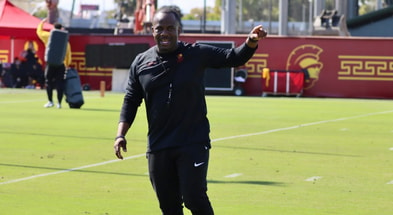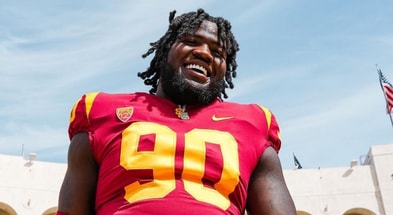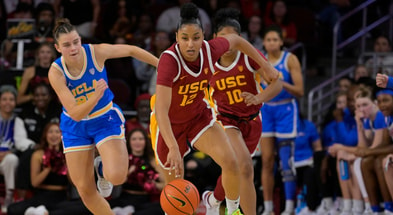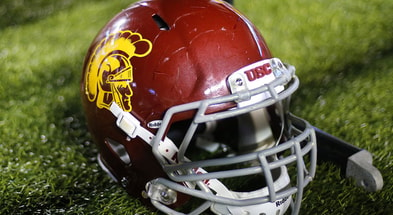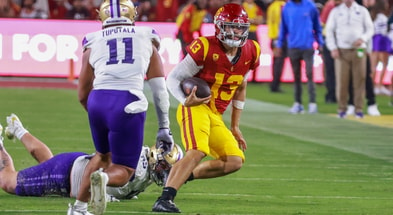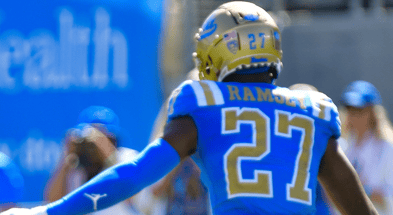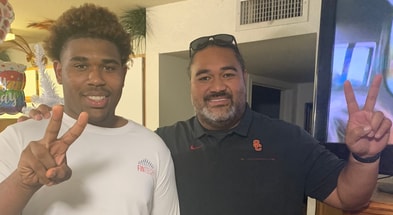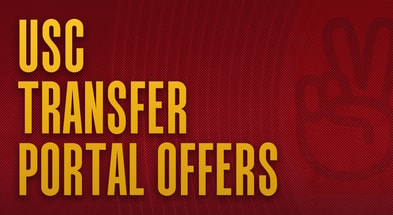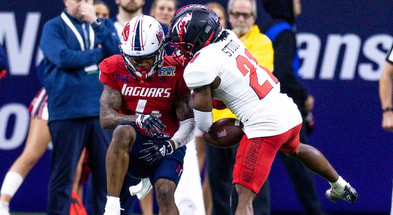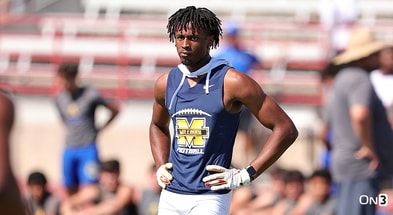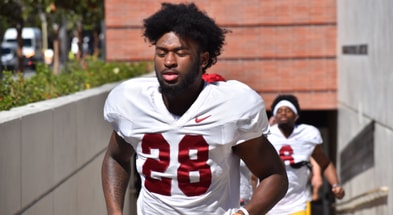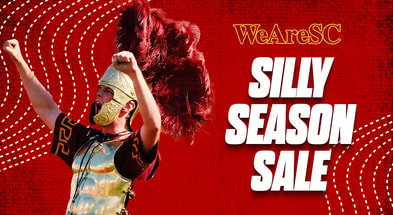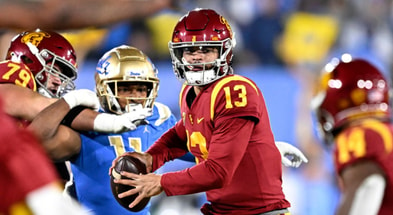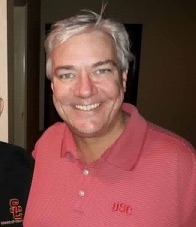O/NSO: Stanford edition
By Greg Katz – WeAreSC.com
The Obvious: Have the unranked USC Trojans (1-1, 0-0 Pac-12 South) improved significantly since the season opening debacle with No. 1 Alabama? Well, we’re about to find out when the unranked Men of Troy travel to No. 7 Stanford (1-0, 0-0 Pac-12 North) for Saturday night’s Pac-12 Conference opener in Stanford Stadium (5 p.m. PDT/ABC).
The Not So Obvious: For the third consecutive season, the Trojans begin Pac-12 play against Stanford, and it’s the fourth time in five years. As you may recall, the Trojans battled Stanford twice last fall, both Stanford victories, including in the Pac-12 Championship Game. The Cardinal have been victorious in six of the last eight contests, but Troy has won in its most recent visitation to Palo Alto (the Trojans have lost just five times there since 1972). The lingering question: Can Clay Helton’s team prove they are capable of beating a Top 10 team like Stanford, which is the media preseason pick to win the 2016 Pac-12 championship?
The Obvious: The Trojans opened a 6½ -point underdog to Stanford.
The Not So Obvious: Before last year’s Pac-12 Championship Game, the previous six games between the Trojans and the Cardinal were decided by 10 points or less. Last season, Stanford pulled away from the Trojans twice in the second half. There is no question that the Cardinal are still potent enough, despite a new quarterback and several player transitions, to do it again. This is also the sixth consecutive season that the Trojans are playing in the Pac-12’s first conference game of the season.
The Obvious: The Trojans/Stanford game will be nationally televised live on ABC (5 p.m. PT/8 p.m. ET)
The Not So Obvious: The ABC broadcasters for Saturday evening’s kickoff will be Joe Tessitore (play-by-play), Todd Blackledge (analysis), and Holly Rowe (sidelines).
The Obvious: Saturday’s Trojans radio game broadcast of the USC/Stanford game will air live on ESPNLA 710 AM at 5:00 p.m. (PDT) with Pete Arbogast (play by play), John Jackson (analyst) and Jordan Moore (sideline).
The Trojans four-hour ESPNLA 710 pregame (1 p.m. PT) and two-hour post-game show on Saturday will feature Arbogast, Jackson, Moore, Shaun Cody, Chris Fisher, Travis Rodgers, WeAreSC publisher Garry Paskwietz, and WeAreSC contributor Jeremy Hogue.
The Not So Obvious: The Stanford broadcast can be heard on flagship station KNBR 680 AM with Scott Reiss (play-by-play), Todd Husick (analyst), and John Platz (sideline). The game is also being broadcast on the Compass Media Network with Matt Hill and Tony Hill. The big Pac-12 game can also be heard on Sirius XM satellite radio (Channel 976) and on the Tuneln Radio app.
The Obvious: The Palo Alto weather on Saturday calls for sunny with a high of 79, 62 percent humidity, and a low of 58 degrees.
The Not So Obvious: The real weather report will be whether the Trojans defense and special teams can stop or at least control Stanford’s junior Heisman Trophy candidate running back and kick/punt returner Christian McCaffrey (6-0, 202). You give McCaffrey an inch and he turns into his childhood idol Reggie Bush, the former Trojans All–America running back/kick returner. While McCaffrey is the major offensive weapon for Stanford, they are by no means just No. 5, which also happens to be the former college number of Reggie Bush. The Cardinal have enough other weapons offensively to give defensive coordinator Clancy Pendergast’s unit all they can handle.
Offensively, the key question is whether the Trojans offensive line can control the Stanford front 7 and can they own the line of scrimmage? Junior Nico Falah, who started against Stanford in the Pac-12 title game, is now starting at center for the fallen Toa Lobendahn (knee), and Falah is now being backed up by junior Khaliel Rodgers, who has returned to offense after having been switched to a defensive nose tackle during August training camp. We’ll see whether the Trojans running backs can make an impact on the game. Tailbacks Justin Davis and Ronald Jones ll (photo above) could make a big difference if the Trojans can mount a consistent ground game. As for the Trojans quarterback situation, it remains to be seen whether they will be given enough time to set up and pass, although redshirt freshman Sam Darnold is much more mobile and extremely dangerous with his legs than starter Max Browne, who is your prototypical pro quarterback. A significant question will be whether the Trojans have a Plan B if All-Pac-12 junior wide receiver JuJu Smith-Schuster is double-teamed and can’t get open. The Trojans have other receiver weapons, but whether they are utilized is the great unknown. This could be the type of game in which the Trojans tight ends became factors both in blocking and receiving. Clay Helton talked about his offense being a running, ball control offense, but the Stanford defense will bring into focus whether that philosophy comes to fruition in this game.
Defensively, we ‘ll see whether the Trojans can stop or at least contain Stanford tailback Christian McCaffrey, who last season was a 2015 All-American, Heisman Trophy finalist, last season’s AP Player of the Year, and Pac-12 Offensive Player of the Year when he set the NCAA season all-purpose yardage record. McCaffrey last season ran effectively twice against the Trojans for a combined total of 322 yards and two touchdowns. All eyes will be on Troy defensive coordinator Clancy Pendergast to devise a scheme that can at least slowdown Mr. McCaffrey. It won’t be easy and don’t be misled that Stanford can’t throw the ball. They can and have a fine receiver in Michael Rector, who had four receptions for 73 yards (18.3 avg.) and one touchdown against Kansas State in the Cardinal opener. A key for the Trojans will be whether inside linebackers Cameron Smith and Michael Hutchings can plug up the holes the entire game. Obviously, the Trojans secondary will be under heavy pressure to contain both the run and the pass, especially when McCaffrey is used as a wide receiver. If you think this season’s edition of the Stanford offensive line is not as solid as accomplished as in the past, be assured that they are a seasoned group that will physically give the Trojans all they can handle.
As he did in his previous tour of coaching duty with the Trojans, John Baxter’s special teams are already paying dividends. Another blocked punt and a punt return touchdown against Utah State give credence Baxter is one of the best special teams coaches in the country. Saturday’s game could get down to special teams, and the Trojans are gaining confidence in left-footed Matt Boermeester, who has already kicked three field goals this season and is perfect in extra point conversions. However, the Trojans will have to guard against the senior leg of Stanford placekicker Conrad Ukopina, who is a proven commodity.
The bottom line to Saturday’s game is whether the Trojans can stop or slow Christian McCaffrey both in scrimmage plays and on punt and/or kickoff returns. Stop McCaffrey and the Cardinal go down a notch. If the Trojans can’t, Saturday’s game could resemble the Pac-12 Championship Game, which he Cardinal dominated the Trojans 40-22.
The Obvious: The 2016 Trojans offense is averaging 25.5 points per game while the Stanford defense is allowing 13 points per outing.
The Not So Obvious: The 2016 Stanford offense is averaging 26 points per game while the Trojans defense is allowing 29.5 points per game.
The Obvious: The Trojans first-year offensive coordinator is Tee Martin, who will look to keep the Stanford defense off balance.
The Not So Obvious: Asked about an overall assessment of the Stanford defense, Martin said, “They’re a really good defense and they are tough. They are technically sound and they’ve been doing it for years. That’s the story of Stanford. They don’t make mistakes, and they are the type of defense that you have to make sure you cross your i’s and dot your t’s. They’re good against the run, and they’re a very experienced group up front although they may not have been stars. However, that No. 90 (Soloman Thomas) really stands out. The linebackers are new, and they return every guy we played against in the Pac-12 Championship Game. It’s a group that knows what they are going and they understand it, and we’ve had only one game to watch them on tape, which was Kansas State. We have to game plan around that what they did to us the last two times we’ve played them.”
The Obvious: The Trojans defensive coordinator is Clancy Pendergast, who will try and devise a strategy to limit the Stanford offense’s potency.
The Not So Obvious: In regards to trying to stop the Stanford offense, specifically All-America tailback Christian McCaffrey, Pendergast says, “He brings a lot of different problems to the table. They line him up and try to feature him in a lot of different formations. He’s the guy they try to get the ball to, and he’s a very explosive athlete. He runs through contact, he’s got very good vision when he has the ball in his hands, and he has very good breakaway speed. Their overall offense gives you a lot of things like multiple personnel groupings and formations and try to get you to adjust. You have to be on your p’s and q’s on just they are trying to do. We have to be really good at playing situational football in groups and in any part of the field.”
The Obvious: The Trojans quarterbacks are junior Max Browne, the starter, and redshirt freshman Sam Darnold, the designated red zone and special situation signalcaller.
The Not So Obvious: Stanford’s quarterback is Ryan Burns (6-5, 233), a senior from Leeburg, Virginia and Stone Bridge High. A former U.S. Army All-America Bowl participant, Burns’s oldest sister, Kelly, played volleyball at North Carolina State.
The Obvious: The Trojans are coming off last weekend’s 45-7 bounceback victory over Utah State.
The Not So Obvious: Stanford opened the season two weeks ago by defeating Kansas State, 26-13, which featured octogenarian K-St. coach Bill Snyder, who has been around so long that his coaching roots can be traced back to being on the Trojans football staff under the legendary John McKay.
The Obvious: The Trojans will draw a “bye week” following the Oct. 15 game at Arizona.
The Not So Obvious: Stanford has already drawn its “bye week” last weekend after opening up against Kansas State on Sept. 3 in Palo Alto.
The Obvious: Before injuries, the Trojans started the season by returning 14 starters (9 offense, 5 defense, 0 special teams).
The Not So Obvious: Before injuries and to start the season, Stanford returned 14 starters (5 offense, 6 defense, 1 special teams).
The Obvious: The Trojans only modern-day, in-season game cancellation involved Stanford in 1924.
The Not So Obvious: At the Trojans’ 1924 game at California on Nov. 1, Troy was informed that beginning in 1925 Cal and Stanford would no longer be playing the Men of Troy. So, the Trojans decided not to wait the year, cancelling its home game the following week (Nov. 8) against Stanford. The Trojans instead hosted—and lost to—St. Mary’s that day. As it turned out, Stanford was back on USC’s schedule in 1925, and the teams have played every year since then except during the war years of 1943-44-45.
The Obvious: Clay Helton has been at USC as an assistant, interim head coach, and permanent head coach for a combined six seasons.
The Not So Obvious: Stanford’s highly successful head coach is David Shaw, the nephew of former Trojans All-American corner (1964-66) and assistant coach (1980-86) Nate Shaw.
The Obvious: The Trojans have played a total of 1,215 games in its history.
The Not So Obvious: Only twice—when Troy snapped No. 1-ranked California’s 38-game regular season unbeaten streak in 1951 at Berkeley and in 2012’s loss at Stanford—has the final score been a very football-like 21-14 (win or lose).
The Obvious: USC is located in Los Angeles and the school has an enrollment of 43,000 (19,000 undergraduates) students.
The Not So Obvious: Founded in 1891, Stanford is located in Palo Alto, California, and has an enrollment of 16,122 (6,994 undergraduate students).
The Obvious: The Trojans have five players who previously attended a Bay Area school.
The Not So Obvious: For the record, those Trojans from the Bay Area are ILB Michael Hutchings (De La Salle HS), SNP Zach Smith (Menlo School), TE Tyler Petite (Campolindo HS), CB Isaiah Langley (Foothill HS) and P Chris Tilbey (San Francisco CC).
The Obvious: The Trojans play in the Los Angeles Memorial Coliseum, which holds 93,607 and is a natural grass field.
The Not So Obvious: Stanford plays in Stanford Stadium, which hold 50,424 and is a natural grass field.
The Obvious: One of the more promising true freshmen on the Trojans is defensive end Connor Murphy.
The Not So Obvious: Murphy’s older brother, Trent, was a consensus All-American outside linebacker at Stanford (2010-13). Trent, to put it mildly, was a freaking stud.
The Obvious: And finally, when the Trojans battle Stanford in football on The Farm, it also marks other sports contests this weekend between the two private universities.
The Not So Obvious: The Trojans men’s water polo team will battle Stanford in Palo Alto prior to the game, while Troy’s men’s tennis team will be playing in nearby Napa during the weekend.
